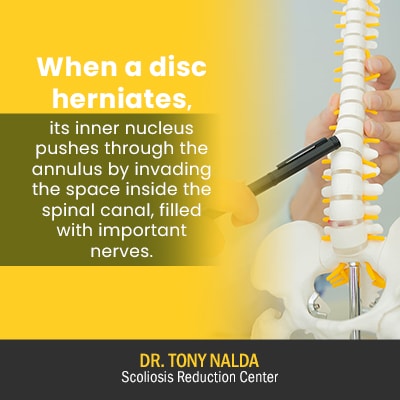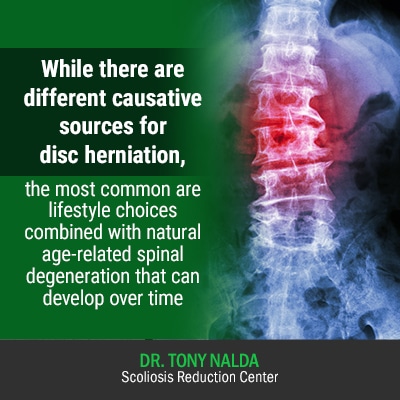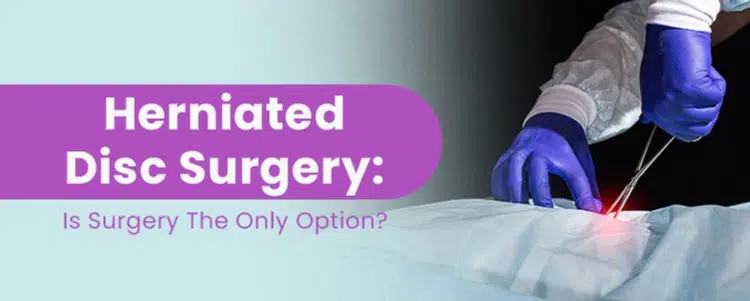There are numerous treatment options for spinal issues, including herniated discs. The spinal discs are crucial for preserving the overall health and function of the spine; they provide cushioning between the vertebrae, act as the spine’s shock absorbers, and facilitate flexible movement. Keep reading to learn more about surgical treatment options, plus less-invasive forms of treatment.
There are different types of herniated disc surgery, including laminotomy/laminectomy, discectomy/microdiscectomy, artificial disc surgery, and spinal fusion. Like any surgery, they come with risks, so less-invasive treatment options should be explored first.
To start our discussion of herniated disc surgery, let’s first briefly discuss the role and structure of the intervertebral discs.
Intervertebral Discs
The spine’s intervertebral discs sit between adjacent vertebrae (bones of the spine) and have two main structures: a tough outer casing called annulus fibrosus and a soft gel-like inner nucleus pulposus.
When a disc herniates, this means the soft inner nucleus has protruded outside of its central position inside the disc by pushing through a tear in the annulus.
While discs can become herniated in any section of the spine, they most commonly occur in the lumbar spine (lower back) and the cervical spine (neck). Bone spurs in the neck can also accompany this, further complicating the situation.
As is the case with most spinal conditions, there are different severity levels, with some causing noticeable symptoms and others that are asymptomatic; this depends on a variety of factors such as patient age and overall health, causation, location of the disc, and the degree of nerve involvement.

When a disc herniates, its inner nucleus pushes through the annulus by invading the space inside the spinal canal, filled with important nerves.
If a nerve is exposed to uneven pressure, it can cause varying levels of localized and/or radicular pain, as well as feelings of tingling and numbness.
The discs are essential structures within the spine that give it structure, provide cushioning between the vertebrae, act as shock absorbers, and facilitate a range of flexible movement by multiple vertebrae combining forces.
The intervertebral discs help the spine maintain its natural, neutral, and healthy alignment with the vertebrae stacked neatly on top of one another.
When a disc herniates, it can change shape, lose hydration, and lose height; as the vertebrae attach to the discs, it can affect the spine’s overall alignment and cause a number of problems felt throughout the body.
So now that we have explored the spinal discs in terms of structure and function, let’s talk about herniated disc surgery and answer the question, “Is surgery the only option?”
Herniated Disc Surgery
Different types of surgeries are used to treat herniated discs: discectomy, cervical corpectomy, laminoplasty, spinal fusion, and spinal laminectomy.
In addition, sometimes surgical procedures are combined to achieve specific results. As a discectomy is the most common herniated disc surgery, let’s start there.
Discectomy
A discectomy involves removing all or part of the damaged disc. When needed, it can be paired with a laminectomy, which involves a surgeon increasing space for the disc and impacted nerve by removing some of the bone that covers the nerve.
Modern discectomy techniques have made the procedure less invasive by performing the surgery through a small incision or tube so a tiny camera can be inserted, along with precise surgical instruments.
Sometimes, this can involve the replacement of a disc with an artificial one, a procedure more common with disc herniation occurring in the neck.
Cervical Corpectomy
Cervical corpectomy is a procedure that removes a section of the vertebra and adjacent disc to facilitate decompression of the spinal cord and nerves in the neck.
Either a bone graft or a metal plate and screws are used to support and stabilize the spine.
Laminoplasty
A laminoplasty accesses the cervical spine through the back of the neck to reconstruct the spinal canal to increase space for the spinal cord and the nerves within.
Spinal Fusion
Spinal fusion involves the use of bone graft (autograft or allograft) and hardware to stabilize the spine.
There are different types of spinal fusion, but most use rods and pedicle screws that are attached to the spine to hold it in a corrective position.
Spinal fusion treatment for a herniated disc can also be combined with a discectomy or laminectomy.
Now that we have discussed some of the most common forms of surgical treatment for disc herniation, let’s discuss why surgery is not the only option and why it shouldn’t be considered until less-invasive forms of treatment have been explored first.
Why Surgery is Not the Only Treatment Option for a Herniated Disc
Every surgical procedure has its share of risks, regardless of surgeons having their patients’ best interests at heart, and while there have been amazing advancements made in terms of surgical techniques that make them as safe as possible, the same can be said of other less-invasive treatment options.
Spinal surgery is not only costly, lengthy, and invasive, it can also leave patients with less mobility in their spine, and in addition, the majority of patients living with a herniated disc don’t require surgery.
There is also herniated disc surgery recovery time to consider and factor in. While every case is different, on average, patients have to wait at least 4 weeks before resuming normal activity levels, although patients who adopt a post-surgical rehabilitation program can sometimes reduce that time and increase their mobility.
There is also the monetary cost of herniated disc surgery to consider; again, while every case is different, on average, an uninsured patient here in the United States can expect to pay anywhere between $20,000 and $50,000. Of course, any complications and related extended hospital stays can increase that estimate, and patients with insurance: $2,000 to $20,000.
Just as there are different types of surgeries for treating a herniated disc, there are different treatment approaches, some focus solely on addressing the symptoms of a herniated disc (pain medication and injections), some focus on treating the underlying condition and proactively improving the health of the spinal discs, and some involve a combination of both strategies.
Here at the Scoliosis Reduction Center®, I offer patients an integrative chiropractic-centered treatment approach that combines different forms of treatment so the condition is treated on multiple levels, leading us nicely to the question of why surgery is not the only option.
Non-Surgical Treatment Options for a Herniated Disc
The non-surgical treatment options for a herniated disc include medications for reducing inflammation and pain, physical therapy and exercise, and chiropractic care.
As a chiropractor, I know the spine and have spent years studying how different conditions affect it, focusing on how best to treat the conditions non-invasively while preserving the spine’s overall health and function.
Through physical therapy and condition-specific custom-prescribed exercises, core strength can be increased, which is ideal in making the muscles surrounding the spine stronger and better able to support and stabilize it and increasing circulation in the area.
Increased circulation in the affected area has huge benefits in terms of disc rejuvenation as the intervertebral discs are the largest structures within the body that don’t have their own vascular supply, meaning no direct path in and out of the discs for transporting blood (oxygen and nutrients) and eliminating waste.
The discs absorb important nutrients through a process of osmosis, so if the surrounding area has increased circulation, the disc has a better chance of rejuvenation and cellular repair.
Chiropractic care also has a place in the treatment of herniated discs. Through a variety of techniques like chiropractic adjustments and flexion-distraction, I can adjust the position of the impacted vertebrae, so they are applying less pressure to the herniated disc, and the nucleus can return to its central position within the disc.
I can also use adjustments and condition-specific exercises to work towards returning the spine to as healthy and natural an alignment as possible so compression of the impacted nerves is reduced.

While there are different causative sources for disc herniation, the most common are lifestyle choices combined with natural age-related spinal degeneration that can develop over time.
In these cases, it’s important to address the condition’s underlying cause. If a patient with a herniated disc is leading a sedentary lifestyle and is overweight, as part of my integrative approach, I don’t just focus on adjusting the spine but also providing guidance on lifestyle changes that are also necessary to improve the overall health and function of the spine and its parts, including the intervertebral discs.
Conclusion
So while surgical techniques for correcting a herniated disc have come a long way over the years, they can be not only costly in monetary terms but can also cost the spine in terms of its overall health. In addition, there are obvious surgical risks of infection, excessive bleeding, nerve damage, etc.
A spine that has parts of a structure removed, altered, fused and/or attached to hardware is more prone to injury, and in many cases, becomes less flexible, impacting mobility.
Here at the Scoliosis Reduction Center®, while my main goal of treatment is always to preserve as much of the spine’s natural function as possible, helping patients avoid invasive surgical procedures and associated hardships is a close second.
While treatment results can never be guaranteed, patients of the Center benefit from an integrative chiropractic-centered treatment approach that combines multiple treatment modalities for the most customized and effective results.





